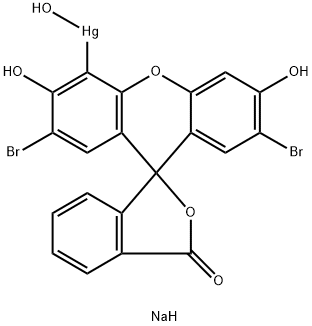MERBROMIN
Synonym(s):2′,7′-Dibromo-5′-(hydroxymercurio)fluorescein disodium salt;Merbromin;Mercurochrome
- CAS NO.:129-16-8
- Empirical Formula: C20H11Br2HgNaO6
- Molecular Weight: 730.69
- MDL number: MFCD00013081
- EINECS: 204-933-6
- SAFETY DATA SHEET (SDS)
- Update Date: 2025-12-15 16:23:17

What is MERBROMIN?
Chemical properties
dark green solid
Originator
Mercurin,Monik
The Uses of MERBROMIN
anthelmintic
The Uses of MERBROMIN
Antiseptic and applied topically
Definition
ChEBI: An organic sodium salt that is 2,7-dibromo-4-hydroxymercurifluorescein in which the carboxy group and the phenolic hydroxy group have been deprotonated and the resulting charge is neutralised by two sodium ions.
Manufacturing Process
49 g 2,7-dibromofluorescein are dissolved in a solution of 8 g of sodium hydroxide in 50 ml of water, and diluted to 200 ml 12.5 ml of glacial acetic acid are added to this solution with stirring. A homogeneous pasty precipitate results with vigorously stirring. A filtered solution of about 22.5 g of mercuric oxide in 25 ml of glacial acid and 50 ml water, diluted after solution to 100 ml, is then added to the suspended precipitate, and the whole diluted to about 500 ml. The mixture is boiled until a small portion of filtered solution gives no test for mercury when treated with ammonium sulfide, the approximate time required for this operation being about 4.5-6 hours. As the boiling continues the precipitate become darker in color and more granular. It is washed, preferably by centrifuging, to remove acetic acid and sodium acetate, and dried at about 110°C. By close adherence to above conditions an almost quantitative yield may be secured. The product may be regarded as consisting essentially of 2,7-dibromo-4-hydroxymercuryfluorescein, resulting from substantially complete hydrolysis of an acetoxy-mercury compound, which probably formed as an intermediate. It is red powder, which is insoluble in the usual solvents but dissolves in two equivalents of sodium hydroxide yielding a deep cherry-red solution. The solution has the tendency to decomposition on long standing.
Therapeutic Function
Antiseptic
Hazard
Toxic by ingestion.
Flammability and Explosibility
Not classified
Safety Profile
Poison by intravenous and subcutaneous routes. Mutation data reported. Relatively nonirritating and nontoxic to damaged skin or tissue. A topical antiseptic. An FDA over-the-counter drug. When heated to decomposition it emits very toxic fumes including fumes of Na2O, Br-, and Hg. See also MERCURY COMPOUNDS, ORGANIC.
Purification Methods
The Na salt is dissolved in the minimum volume of H2O, or the free acid suspended in H2O and dilute NaOH is added to cause it to dissolve, filter and acidify it with dilute HCl. Collect the precipitate, wash it with H2O by centrifugation and dry it in a vacuum. The di Na salt can be purified by dissolving it in the minimum volume of H2O and is precipitated by adding EtOH, filter, wash it with EtOH or Me2CO and dry it in a vacuum. Its solubility in 95% EtOH is 2% and in MeOH it is 16%. [White J Am Chem Soc 42 2355 1920.]
Properties of MERBROMIN
| Melting point: | ≥300 °C |
| storage temp. | Poison room |
| solubility | Water : ≥ 50 mg/mL (66.43 mM);DMSO : 6.67 mg/mL (8.86 mM) |
| form | crystalline |
| color | green |
| Odor | Odorless |
| PH Range | 8.5 - 9 |
| Water Solubility | 2.561g/L at 25℃ |
| Merck | 13,5892 |
| Stability: | Stable. Incompatible with strong oxidizing agents, strong acids. |
| CAS DataBase Reference | 129-16-8(CAS DataBase Reference) |
| EPA Substance Registry System | Mercury, (2',7'-dibromo-3',6'-dihydroxy-3-oxospiro[isobenzofuran-1(3H),9'-[9H]xanthen]-4'-yl)hydroxy-, disodium salt (129-16-8) |
Safety information for MERBROMIN
| Signal word | Danger |
| Pictogram(s) |
 Skull and Crossbones Acute Toxicity GHS06  Health Hazard GHS08  Environment GHS09 |
| GHS Hazard Statements |
H373:Specific target organ toxicity, repeated exposure H410:Hazardous to the aquatic environment, long-term hazard |
| Precautionary Statement Codes |
P262:Do not get in eyes, on skin, or on clothing. P273:Avoid release to the environment. P280:Wear protective gloves/protective clothing/eye protection/face protection. P314:Get medical advice/attention if you feel unwell. |
Computed Descriptors for MERBROMIN
MERBROMIN manufacturer
New Products
4,4-Difluoropiperidine hydrochloride tert-butyl 9-methoxy-3-azaspiro[5.5]undecane-3-carboxylate Indole Methyl Resin N-Isopropylurea N,N-Dicyclohexylcarbodiimide(DCC) MELDRUMS ACID 5-METHYLISOXAZOLE-4-CARBOXYLIC ACID Magnessium Bis glycinate Zinc ascorbate 1-bromo-2-butyne 2-acetamidophenol 9(10H)-anthracenone Erythrosin B, 4-Piperidinopiperidine 2-((4-morpholinophenylamino) (methylthio) methylene) malononitrile 2,4-dihydroxybenzaldehyde 3-(4-morpholinophenylamino)-5-amino-1H-pyrazole-4-carbonitrile Methyl 2-methylquinoline-6-carboxylate 2,6-dichloro-4-nitropyridine 4-Bromo-2-chlorobenzonitrile 2-(benzylamino)acetic acid hydrochloride 4-(tert-Butoxycarbonylamino)but- 2-ynoic acid 3,4-dihydro-2H-benzo[b][1,4]dioxepine 1-Phenyl-1-cycloprppanecarboxylicacidRelated products of tetrahydrofuran








You may like
-
 129-16-8 Merbromin 99%View Details
129-16-8 Merbromin 99%View Details
129-16-8 -
 Merbromin 129-16-8 99%View Details
Merbromin 129-16-8 99%View Details
129-16-8 -
 MERCUROCHROME 99%View Details
MERCUROCHROME 99%View Details
129-16-8 -
 Mercurochrome CAS 129-16-8View Details
Mercurochrome CAS 129-16-8View Details
129-16-8 -
 Mercurochrome 97.5% CAS 129-16-8View Details
Mercurochrome 97.5% CAS 129-16-8View Details
129-16-8 -
 MERCUROCHROME Extra Pure CAS 129-16-8View Details
MERCUROCHROME Extra Pure CAS 129-16-8View Details
129-16-8 -
 20677-73-0 (2,2-diethoxyethyl)methylamine 98%View Details
20677-73-0 (2,2-diethoxyethyl)methylamine 98%View Details
20677-73-0 -
 3-(4-(hydroxyamino)-1-oxoisoindolin-2-yl)piperidine-2,6-dione 98%View Details
3-(4-(hydroxyamino)-1-oxoisoindolin-2-yl)piperidine-2,6-dione 98%View Details
